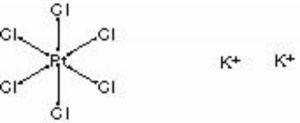Difference between revisions of "Potassium chloroplatinate"
Jump to navigation
Jump to search
(username removed) |
(username removed) |
||
| Line 42: | Line 42: | ||
== Authority == | == Authority == | ||
| − | * | + | * Richard S. Lewis, ''Hawley's Condensed Chemical Dictionary'', Van Nostrand Reinhold, New York, 10th ed., 1993 |
| − | * | + | * R.D. Harley, ''Artists' Pigments c. 1600-1835'', Butterworth Scientific, London, 1982 |
* ''CRC Handbook of Chemistry and Physics'', Robert Weast (ed.), CRC Press, Boca Raton, Florida, v. 61, 1980 Comment: ref. index=1.827 | * ''CRC Handbook of Chemistry and Physics'', Robert Weast (ed.), CRC Press, Boca Raton, Florida, v. 61, 1980 Comment: ref. index=1.827 | ||
Revision as of 06:27, 24 July 2013
Description
A yellow crystalline powder. Potassium chloroplatinate was sold for a short time in the late 18th and early 19th century as an artists pigment, called platina yellow. It was initially called lemon yellow. Potassium chloroplatinate is now used in photography.
Synonyms and Related Terms
lemon yellow; platina yellow; platinum potassium chloride; potassium platinichloride
Other Properties
Slightly soluble in water. Insoluble in ethanol.
| Composition | K2PtCl6 |
|---|---|
| CAS | 16921-30-5 |
| Melting Point | 250 (dec) |
| Density | 3.499 |
| Molecular Weight | mol. wt. = 485.9946 |
| Refractive Index | 1.827 |
Hazards and Safety
Toxic by ingestion and inhalation. Contact may cause irritation or allergic reactions.
Fisher Scientific: MSDS
Authority
- Richard S. Lewis, Hawley's Condensed Chemical Dictionary, Van Nostrand Reinhold, New York, 10th ed., 1993
- R.D. Harley, Artists' Pigments c. 1600-1835, Butterworth Scientific, London, 1982
- CRC Handbook of Chemistry and Physics, Robert Weast (ed.), CRC Press, Boca Raton, Florida, v. 61, 1980 Comment: ref. index=1.827
